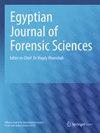汗毛孔随性别和年龄变化的双人比较:对德里-中北部地区人口的简要皮肤地形调查
IF 1.3
Q3 MEDICINE, LEGAL
引用次数: 0
摘要
在法医调查中,使用部分指纹进行个人身份鉴定是一项重大挑战。鉴于这些限制,汗孔特征已被证明是一种可能的替代方法。然而,由于汗孔微小,对其进行的研究十分有限。本研究旨在研究德里-NCR(国家首都地区)人群的汗孔频率、汗孔形状(圆形和非圆形)以及汗孔位置(中间和外围)与性别、双亲和年龄的差异。由于没有通用的方法来界定毛孔分析的评估区域,我们使用指纹图案来划定 9 平方毫米的分析区域。我们使用显微镜检查了 200 名年龄在 18-60 岁之间的个人(100 名男性和 100 名女性)的轧染指纹。对所有指纹的数据进行了分析,并就不同变量进行了比较。结果表明,男女双方指纹的差异在统计学上都很明显。在女性中,除了中间位置的毛孔数量外,所有研究过的毛孔特征在右手都明显高于左手。在男性中,只有外围位置的毛孔数量右手明显多于左手。不过,在孔隙特征方面,两性之间和不同年龄组之间没有观察到明显差异。此外,男性的一些毛孔特征与年龄有明显的相关性,而女性则没有明显的相关性。显著的双手差异凸显了孔隙特征在法医实践中的潜在应用;在法医实践中,指纹检验员可以确定犯罪时可能使用的手,从而加强部分指纹的证据价值。这些发现还表明,个人的性别和年龄无法通过孔隙特征来确定。本文章由计算机程序翻译,如有差异,请以英文原文为准。
A bimanual comparison of variation in sweat pores with sex and age: a brief dermatoglyphic survey of population in Delhi-NCR
Personal identification using partial fingerprints poses a major challenge in forensic investigations. In light of such restrictions, sweat pore characteristics have shown to be a possible alternative. However, limited research has been done on these due to their minute size. The present study was undertaken with the objective of studying the differences in pore frequency, pore shapes (circular and non-circular), and pore positions (middle and periphery) with respect to sex, bimanual, and age in the population of Delhi-NCR (National Capital Region). As there is no universal approach for defining the evaluation area of pore analysis, we used fingerprint patterns to demarcate a 9mm2 area of analysis. The rolled-inked fingerprints of 200 individuals (100 males and 100 females) belonging to 18-60 years of age were examined using microscopy. The obtained data for all prints was analysed and compared with respect to the different variables. The results showed statistically significant bimanual variations for both sexes. In females, all studied pore characteristics except the number of pores at the middle position were significantly higher in the right hand as compared to the left hand. In males, only the number of pores at the peripheral position was significantly higher in the right hand as compared to the left hand. However, no significant differences were observed in pore characteristics between the two sexes and among the different age groups. Moreover, several pore characteristics showed a significant correlation with age in males as compared to females where no significant correlations were observed. Significant bimanual variations highlighted the potential application of pore characteristics for forensic practice; wherein a fingerprint examiner might determine the probable hand used for the commission of the crime, thereby strengthening the evidentiary value of partial fingerprints. These findings also suggest that the sex and age of an individual cannot be determined by pore characteristics.
求助全文
通过发布文献求助,成功后即可免费获取论文全文。
去求助
来源期刊

Egyptian journal of forensic sciences
MEDICINE, LEGAL-
CiteScore
2.00
自引率
0.00%
发文量
51
审稿时长
17 weeks
期刊介绍:
Egyptian Journal of Forensic Sciences, the official publication of The International Association of Law and Forensic Sciences (IALFS), is an open access journal that publishes articles in the forensic sciences, pathology and clinical forensic medicine and its related specialities. The journal carries classic reviews, case studies, original research, hypotheses and learning points, offering critical analysis and scientific appraisal.
 求助内容:
求助内容: 应助结果提醒方式:
应助结果提醒方式:


